Hyacinthaceae
Hyacinthaceae
Family: Hyacinthaceae
Common names: hyacinth family
Introduction
This is a family of 700-900 species of deciduous, or rarely evergreen, bulbous plants, several with brightly coloured flowers, that is well represented in South Africa.
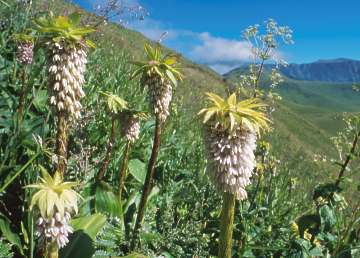
Description
Description
The plants are deciduous or rarely evergreen perennials with a bulb, which can sometimes be quite large. The leaves are usually lance-shaped and soft-textured, with rather slimy sap. The leaves are mostly held upright but in several species from the South African winter rainfall area they lie flat against the ground. Mostly the leaves are smooth and unmarked but in most species of Ledebouria (also some Lachenalia and Eucomis from South Africa) the leaves are attractively spotted or streaked with purple or dark green. Occasionally the leaves may have their upper surface covered with warts or pustules, or coarse hairs, especially in species of Lachenalia and Massonia. In some species the leaves are narrow and needle-like or cylindrical. The flower stalk is leafless and the flowers are always arranged in racemes. Sometimes these may be very short so that the flowers are crowded into a head-like cluster. In the genera Bowiea and Igidiae the raceme is highly branched and sprawls through the surrounding vegetation. Each flower arises in the axil of a bract, which may be large and leaf-like or minute and vestigial. In the subfamily Urgineoideae the lower bracts have a flattened spur at their base. In some genera a second smaller bract arises on the base of the flower stalk, or pedicel, as well.
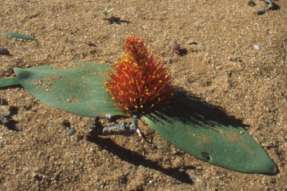
The flowers are mostly radially symmetrical with six tepals (petals) arranged in two whorls of three each. These may be similar to one another, or the inner three may differ slightly from the outer three, often just in shape but sometimes also in size and markings. In a very few species of Daubenya the lower flowers in the raceme are more or less two-lipped and thus bilaterally (not radially) symmetrical. The flowers vary in colour from dull greenish or grey, through white, to blue, yellow, orange or red. In several speciesof Lachenalia they are multicoloured, often with dark tips on the outer three tepals. In some species the flowers are very fragrant. The petals are either separate or joined at the bottom into a short or long tube. The flowers of most species last several days but are much shorter-lived in all species of Drimia, where they last just a few hours or a single day at most. The six stamens are inserted at the base of the petals or just within the tube (if present). The ovary is superior with three locules each containing several to many ovules attached to the centre. Each flower has a single style.
The fruit is a dry capsule that splits open along three sides to release the seeds. These are very variable in shape. In most genera they are tetrahedral or variously angled and without obvious adaptations for dispersal. Flattened seeds with wing-like edges that are adapted to wind dispersal characterise the subfamily Urgineoideae, whereas glossy, globose or pear-shaped seeds characterise the subfamily Hyacinthoideae. No species have fleshy seeds.
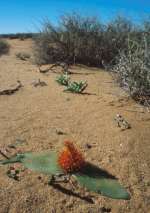
The species grow in all sorts of soils, derived from granite, basalt, dolerite, clay, limestone and sandstone. Most species favour loamy or clay soils, often among rocks where drainage is good, but some grow in marshes and others in pure sand. Species grow from the coast to the top of the interior escarpment at over 3 000 m. Relatively few species are very localised in occurrence, but the species ofDaubenya is a notable exception.
Distribution and habitat
Distribution description
Throughout Africa and the Mediterranean and near-East into India, with a few species in western South America. The family is mostly found in seasonal climates with a pronounced dry season and is rare in tropical lowlands and forested areas. It is best represented in southern Africa, particularly in the winter rainfall parts, with a second centre of diversity in the Mediterranean basin. Somewhere between 700-900 species are known world-wide, just over half of them in southern Africa. Almost 200 species alone are known from the Cape Floral Region. Different botanists have very different opinions about the boundaries of the genera. The number of genera recognised from sub-Saharan Africa by different botanists ranges from around 40 at the one extreme to 15 at the other. The motivation for these changes has been to reflect accurately the evolutionary relationships of the species. In the past, genera were often defined on the appearance of the flowers. With hindsight it seems that in many cases these differences merely reflected different pollination strategies between groups of species, and not more fundamental differences in the their evolutionary history.
The family is best represented in open, seasonal habitats. The richest areas for species in southern Africa are the succulent karoo and fynbos of the Northern and Western Cape, with most species ofLedebouria and Eucomis found in the montane grasslands of eastern South Africa, Swaziland and Lesotho. Fewer species occur in savanna, semi-arid central karroo and forest.
Derivation of name and historical aspects
History
The family name is based on the genus Hyacinthus, which actually comprise just two or three species from the middle East. The genus Hyacinthus dates from 1753, when it was coined by Swedish botanist Carl Linnaeus. Its name derives from the Greek myth in which a beautiful flower, variously described as dark red or purple, sprung from the blood of the handsome youth Hyacinthus, the beloved of Apollo, and accidentally struck down by the god. Several different plants have been identified with the myth but it is most likely that it originally referred to Gladiolus italicus, whose lower petals bear graphic markings that could be construed to represent the Greek letters AI that were supposed to have been inscribed on the mythological flower.
Class: Angiospermae (monocotyledons) Order: Asparagales
The circumscription of the genera and the relationships between them have long been contentious. Recent DNA analyses have provided the first firm foundation for subdividing the family, and it is now accepted that there are four subfamilies:
- Subfamily Oziröeoideae contains the single genus Oziröe with five species from western South America. They resemble small species of Ornithogalum with whitish, star-shaped flowers.
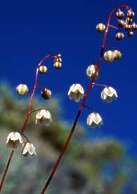
- Subfamily Urgineoideae contains about 100 species. In the classification of Manning et al. (2004) these are distributed among three genera. The subfamily is recognised by the spurred bracts at the base of the flowers; the seeds are flattened and wrinkled with a rim-like wing; and the bulbs are often highly poisonous, containing characteristic toxic steroids (bufodienaloids). The largest genus, Drimia, is recognised by its short-lived flowers, each lasting just a few hours or up to a single day. New buds open each day so that usually only one or a few flowers are open at a time. The remaining two genera in the subfamily, Bowiea (Africa) and Igidia (Madagascar), have just a single species each and have longer-lived flowers and highly branched inflorescences that sprawl among the surrounding vegetation.
- Subfamily Ornithogaloideae contains around 200 species. The subfamily is recognised by its flattened or angled seeds without peripheral wings. The flowers are usually whitish or green to brown, but O. dubium has bright yellow or orange flowers. Many species are poisonous, containing toxic cardenolids. The genera in this family have been most radically affected by the various treatments. In the classification of Manning et al. (2004), all of the species are contained within the single genus Ornithogalum. This includes those previously placed in genera such as Albuca, Dipcadi and Galtonia.
- Subfamily Hyacinthoideae includes the remaining species (just over 200 in sub-Saharan Africa). It contains some of the most colourful species in the family, including blue Hyacinthus and Scilla, and multicoloured Lachenalia. Although for long considered to occur in southern Africa, the genusScilla is now known to be strictly northern hemisphere and the southern African species previously included in it have been accomodated in several other genera, mostly with just one or a few species each (Scilla natalensis = Merwilla plumbea).
Ecology
Ecology
Members of Hyacinthaceae occur in a great variety of habitats. About the only place they do not grow is in the sea itself, although several species of Lachenalia and Ornithogalum grow in coastal sands within reach of the spray. Most species are adapted to seasonal climates that have a pronounced dry or cold period unfavourable for plant growth, and during which the plants are dormant. As a result, most species are deciduous. Evergreen species are restricted to subtropical forests or savannah, temperate grasslands, and perennially moist fynbos. A few species grow in marshes or along streams, and some even grow only in the spray of seasonal waterfalls.
The above-ground parts (leaves and stems) of deciduous species die down when the bulb or corm enters dormancy. The plants thus survive periods that are unfavourable for growth by retreating underground. This is particularly useful in grasslands and fynbos, which are adapted to regular burning in the dry season. At this time the plants are dormant and their bulbs or corms are able to survive the heat of the fires underground. Veld fires clear the soil surface of competing vegetation, as well as fertilise it with ash. With the arrival ofthe first rains, the dormant corms are ready to burst into growth, sending up flowers and stems before they can be shaded out by other vegetation. Many species of Drimia delay their flowering until the dry season, at which time the leaves are withered and are often blown away.
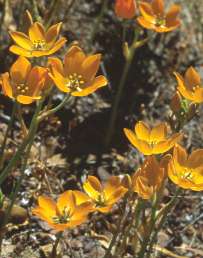
The family has a relatively diverse pollination ecology, especially in winter rainfall regions of southern Africa. Most species are pollinated by various species of solitary bees but some, like the genus Veltheimia, and a few species of Lachenalia and Daubenya, are adapted to pollination by sunbirds. These species typically have red to orange, trumpet-like flowers that secrete large amounts of nectar. The group of species previously placed in Dipcadi (now included by some in Ornithogalum) are adapted to pollination by moths, and secrete a rather strong fragrance at night. The brightly coloured species of Ornithogalum, such as O. dubium and Daubenya aurea, are pollinated by monkey-beetles, while some species of Massonia are visited by rodents.

Uses
Use
Several genera are important in horticulture, both as cut flowers and as garden plants. The most important cut flowers are Ornithogalum thyrsoides and O. conicum, known affectionately as chinkerinchees for the squeaking sound that their stems produce when rubbed gently together. These long-lasting flowers were shipped to Britian in large numbers from South Africa during the Victorian period. Among the garden plants the genera Hyacinthus, Hyacinthoides and Muscari are the most important Mediterranean ones, while among the South African genera, Ornithogalum (Galtonia), Veltheimia and Eucomis are widely cultivated. The evergreen Drimiopsis (previously known as Drimiopsis maculata but now included in the genus Ledebouria as L. petiolata) is a very popular house-plant, producing attractive arrow-shaped leaves marked with dark green spots.
Species of Orntihogalum are among the most poisonous plants in South Africa and may lead to stock losses if contaminated fodder is eaten. Species of Drimia and Bowiea are also highly toxic, but are used in small doses in traditional medicine to treat various illnesses. Overdosage can be fatal.
Growing Hyacinthaceae
Grow
In the Garden, species of Hyacinthaceae are generally easy to cultivate and flower regularly as long as their need for a resting season is taken into account. Otherwise the bulbs are prone to rotting. Generally speaking, species from the east coast, which has a less seasonal climate, are easiest in gardens. This includesVeltheimia bracteata and species of Eucomis. Species from the summer rainfall areas require a dry winter resting period, whereas those from the winter rainfall region require a cool, moist winter growing season and a dry summer.
References
- Leistner, O.A.(ed.). 2000. Seed plants of southern Africa: families and genera. Strelitzia 10. National Botanical Institute, Pretoria.
- Manning, J., Goldblatt, P. & Snijman, D. 2002. The color encyclopedia of Cape bulbs. Timber Press, Oregon.
- Manning,J., Goldblatt, P. & Fay, M. 2004. A revised generic synopsis of Hyacinthaceae in sub-Saharan Africa, based on molecular evidence, including new combinations and the new tribe Pseudoprospereae. Edinburgh Journal of Botany 60: 533-568.
Credits
John Manning
Compton Herbarium
October 2004
Plant Attributes:
Plant Type: Bulb
SA Distribution:
Soil type:
Flowering season:
PH:
Flower colour:
Aspect:
Gardening skill:
Special Features:
Horticultural zones






Rate this article
Article well written and informative
Rate this plant
Is this an interesting plant?
Login to add your Comment
Back to topNot registered yet? Click here to register.